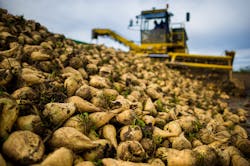When I was a kid my grandparents had a cottage located not far from a sugar beet farm. One day as we drove past the farm, I convinced my dad to pull over so I could grab a sugar beet that was lying near the road – it had likely fallen off the combine that collected it. I wanted to use it for show-and-tell at school. I have no idea why at the time I was so enamored with sugar beets – other than probably thinking I could cut it open and access delectable sugar. I soon learned that wasn’t exactly the case when I presented my agricultural find to my third-grade class. Right after I informed the class that in the mid-1700s German chemist Andreas Marggraf discovered that sugar beet roots contained sucrose, the same sugar as that of sugar cane, I cut open my prized beet (yes, eight-year-old me went to school with a knife) and took a bite of the innards and was immediately disappointed by the barely-there sugar taste. It tasted more like a raw potato than a sweet treat.
While my displeasure with its taste remains, I discovered that my fascination with raw sugar stock is still going strong. I read a recent press release highlighting a discovery from the University of Queensland (UQ), Australia. Researchers have found a way to more efficiently convert sugar cane into a building block of aviation fuel and other products.
By zeroing in on a specific enzyme, a UQ team working in collaboration with the Technical University of Munich has sped up the slowest step in processing sugar into a chemical called isobutanol.
Professor Gary Schenk from UQ’s School of Chemistry and Molecular Biosciences said isobutanol from a renewable resource could be used to make fuels, plastics, rubbers and food additives.
“Our research into this particular enzyme means we can accelerate the production rate and yield of isobutanol from sugar cane, ultimately enabling biomanufacturers to make diverse products at scale sustainably and efficiently,” says Schenk.
Maybe all those years ago what I tasted from my sugar beet was future fuels. One kid’s disappointment is another’s inspiration.
About the Author
Traci Purdum
Editor-in-Chief
Traci Purdum, an award-winning business journalist with extensive experience covering manufacturing and management issues, is a graduate of the Kent State University School of Journalism and Mass Communication, Kent, Ohio, and an alumnus of the Wharton Seminar for Business Journalists, Wharton School of Business, University of Pennsylvania, Philadelphia.

